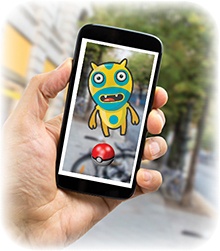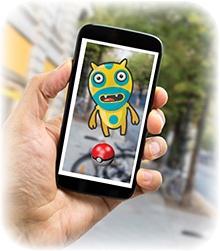In just a few months, the Pokémon GO1 app hit nearly 50 million downloads. And it’s motivated millions of people to grab their smartphones and tap, swipe, walk, and hunt down digital creatures. Sounds pretty good if you’re running a wellness program and want to encourage people to get more exercise. Right?
After all, at least half of all adults fall short of getting the minimum 30 minutes of exercise a day, according to the Centers for Disease Control and Prevention. 2 But could the popular app pose a potential problem for wellness programs? You might be surprised. But first the benefits…
More Steps for Participants
Take a closer look at people in the park, on the street, or even at work and see what they’re doing on their smartphones. After checking email, sending text messages, and watching funny cat videos, there’s a good chance those people are playing Pokémon GO.
For example, just after the app was released SAIF Corporation Benefits & Wellness Manager Renae Coombs3 noticed an uptick in teenager foot traffic in her neighborhood. And they were all playing Pokémon GO. Then her teenage nephew came for a visit.
“My husband and I took the kids out for a walk,” says Coombs. “We usually just see the regular dog walkers and runners. But this time there were all kinds of teenagers out there. You know, out of hiding in the basement and off the Xbox controllers. And they were all playing Pokémon GO.”
Not long after that, Coombs’ cousin and her teenage son came to visit. And he said he wanted to scout out the neighborhood on foot in search of Pokémon, so she jumped at the chance to learn more about it.
“My nephew is a super kid,” says Coombs. “But the last time we were together, we took this hike along the coast to see a couple of lighthouses, and he hated every minute of it. But put his mom’s phone in his hands and let him look for Pokémon, and he’d walk to the ends of the earth.”
Since then, SAIF employees have been playing Pokémon GO on the company’s tree-lined campus in Salem, Ore. And it’s gaining traction as a way to encourage people to be more active.
“A cool thing about Pokémon GO,” says Coombs, “is that it’s fun. Right? Some of us think that working out in a fitness center is fun. But a lot of people maybe don’t. Pokémon GO is something people can do at work that’s contagious, that’s energetic, and that people talk about.”

Headaches for Wellness Programs
But before you send out a company-wide email promoting the health benefits of Pokémon GO, or encouraging participants to download the app, there is a potential for some unexpected headaches.
That’s what Rhoda Mason4 discovered shortly after the app was released. She’s the employee health and safety manager at Sutter Physician Services in California.
“We literally had people who were playing Pokémon GO walk into a hospital, down the hall, and into a patient’s room,” says Mason. “And that wasn’t the only incident. At another location, we had Pokémon GO players trying to piggyback employees with badge access to get in a secure building. It was pretty crazy, and created a huge security concern.”
Sutter Health operates 24 hospitals in California, a network of medical and administrative offices, and employs more than 50,000 people. In an average year, Sutter Health handles close to 1 million ER visits, and more than 11 million outpatient visits. With two Pokémon GO incidents that had the potential to pose a security risk, Sutter Health had to take action to keep employees and patients safe.
“We actually prohibited employees and anyone who visits any of our locations from playing Pokémon GO,” says Mason. “We posted signs at all of our locations that warned people not to play the game. And we sent out an email to all of our employees that said the game should not be played at work, even during a break or meal, and explained potential security risks of playing the game.”
Mason recognizes that Pokémon GO does have the potential to encourage people to be more active, and could be used in wellness programs. But the dogged pursuit of digital Pokémon by some people during the first few weeks after the app was released was just a little too crazy for Sutter Health to support.
“The first few weeks after the app was released were a little crazy,” says Mason. “It’s died down now, and not as much of a security concern. But we still have signs posted that let people know playing Pokémon GO is prohibited.”
So what is Sutter Health doing to encourage people to be more active if Pokémon GO isn’t part of employee culture like it is at SAIF and many other organizations?
“We just kicked off a daily step challenge,” says Mason. “The goal is to encourage employees to walk at least 10,000 steps a day for 28 days. People can use a mobile app to track their steps, or a fitness tracking device like the FitBit or Apple watch to measure their progress. At the end of the month, there’s a raffle and prizes for people who hit that goal.”
Is Pokémon GO part of your wellness program? Why or why not?
References
- Pokémon GO - App Store revenue & download estimates - US. (2016). Retrieved September 08, 2016, from https://sensortower.com/ios/us/niantic-inc/app/pokemon-go/1094591345/#
- Exercise or Physical Activity. (2016). Retrieved September 08, 2016, from http://www.cdc.gov/nchs/fastats/exercise.htm
- Coombs, R. (Presenter). (2016, Aug. 19). Maximizing your Total Rewards package to help attract and retain great talent. HR Summit 2016 & Healthiest Employers of Oregon and HR Leadership Awards.
- Mason, R. (2016, Sept. 1). Personal interview with Evan Jensen at Wellsource Inc.







